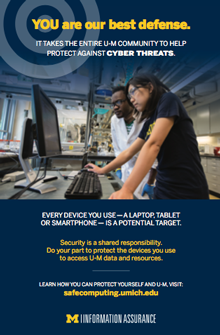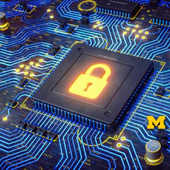Pilots of anti-phishing education programs that feature self-phishing concluded this fall at Michigan Medicine and UM-Flint. Participants in both pilots improved their ability to recognize phishing.
Michigan Medicine. Two units—Family Medicine and Pathology—volunteered to participate in the pilot, and extensive communication was conducted with participants before and after simulated phishing email campaigns. Over a period of three months, three simulated phishing emails were sent. From 4% to 12% of participants clicked the malicious links in the messages, depending on the message. Those who responded to surveys reported a greater understanding of phishing and how to recognize it after the pilot.
Based on the pilot, Information Assurance (IA) and Health Information Technology & Services (HITS) now have a good understanding of the logistics involved in setting up and managing simulated phishing emails. Together, they worked out triage procedures for managing and tracking reports for both simulated and actual phishing simultaneously. IA and HITS staff members are planning to begin phasing in the anti-phishing education program across Michigan Medicine during 2018.
UM-Flint. UM-Flint Information Technology Services (ITS) sent three simulated emails over a period of three months. Staff members adapted and supplemented communications used for the Michigan Medicine pilot that were developed by Information Assurance (IA). ITS provided customized training for members of the UM-Flint community.
UM-Flint ITS staff report that the number of people who clicked the malicious link in the simulated phishing email fell dramatically over the course of the pilot, with 256 people clicking the malicious link in the first message and 59 clicking it in the third. ITS staff concluded that,"the campaign improved IT security knowledge and the ability of users to identify and report phishing threats."









